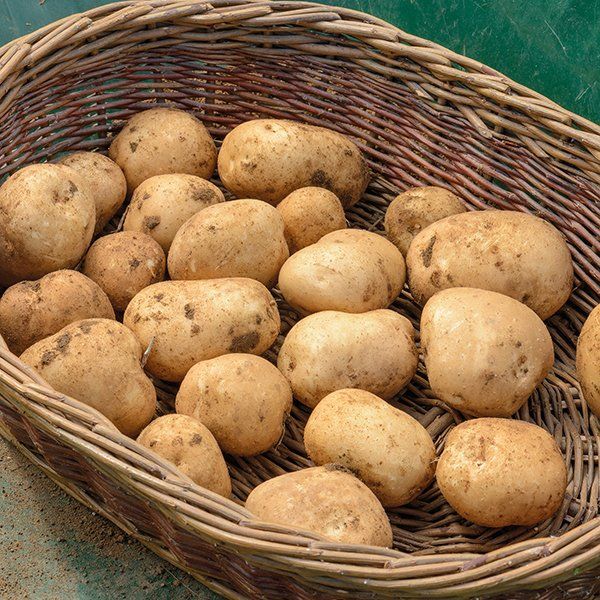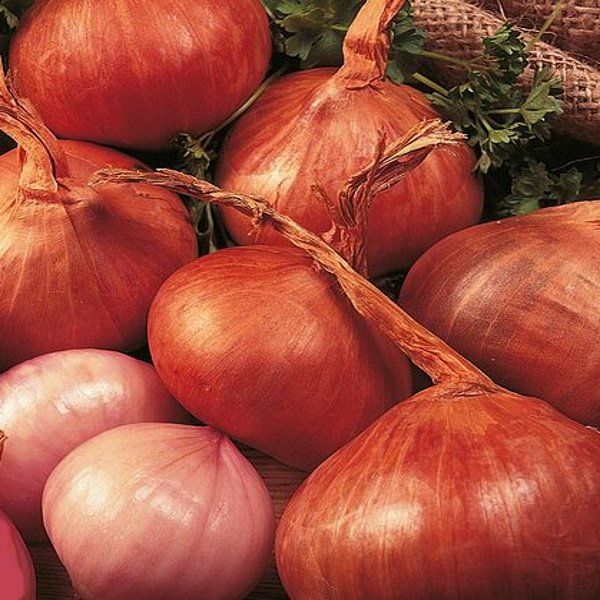
SEED POTATOES
FIRST
EARLIES
First early or ‘new’ potatoes are so-called because they are the earliest to crop. They take 10-12 weeks to mature.
Plant 30cm apart, with 60cm between rows, around 12cm deep. Do not store well and best eaten soon after harvest

Traditionally one of the countries favourite garden grown seed potatoes, white skin and flesh makes for an excellent new potato, is perfect for salads and performs well for baking and even roasting. Arran Pilot has a high resistance to scab and a good resistance to spraing.
A clean, smooth white, with shallow eyes, the Casablanca has great cooking ability. Chip, bake, boil, mash or roast it. These seed potatoes have been noted to have good resistance to common and powdery scab.

Maris Bard produces high yielding crops of a good even size. These seed potatoes are oval shaped with white skins, shallow tuber eyes and white flesh. Maris Bard are best suited to boiling and early salad use in the kitchen - simply dig, wash, boil and serve. Good resistance against common scab

Pentland Javelin produces heavy crops of short, oval, white skinned tubers with pure white, tasty flesh.These seed potatoes are great to simply throw into the pan and boil for salads.Pentland Javelin has good all-round disease resistance to common scab and blackleg.

Rocket's ability to grow large crops of uniformed, round tubers made it very popular.Considered to be one of the better exhibition potatoes at the time, Rocket tubers are white fleshed and skinned, with shallow eyes and a mild taste. Great for boiling and with salads. These seed potatoes have good resistance to blackleg, common scab and spraing.
A high yielding variety that produces a round-to-oval shaped white tuber with creamy flesh and shallow eyes, this seed potato is a real all-rounder in the kitchen. Great disease resistance to blackleg, common scab, powdery scab and eelworm, Swift is an ideal variety to grow in containers for early use.

Ulster Prince tubers are long and white, with shallow eyes and white flesh. These seed potatoes also have good resistance to common scab, powdery scab and disintegration in the pan when boiling.
Excellent drought resistance makes
SECOND EARLIES
Second Earlies are planted out from about February to March and are harvested from July to October. Again, this is dependant on weather conditions and is likely to vary slightly from season to season.
Second Early potatoes should be planted in rows, allowing about 1½ft (45cm) between tubers and 2½ft (75cm) between rows.
Second Early Potatoes take approximately 13-14 weeks from planting to harvest. They are ideal for growing in tubs and potato planters.

This French-bred, highly popular potato is the salad variety of choice of many discerning chefs. The smooth skinned tubers have a light yellow flesh which has a wonderful flavour and delightfully waxy texture. A further advantage is its resistance to scab and blight making it a must for all potato lovers.
A smashing variety for roasting and chipping, as it does not absorb too much oil. The healthy plants are double eelworm-resistant and have good resistance to slugs and blackleg. The long, white skinned tubers have purple eyes and are often seen on the showbench.

With white skin, firm flesh and good flavour, second early potato ‘Nadine’ is ideal for boiling and sautéing. This disease-resistant variety produces high yields of potatoes that store well.

Produces a good harvest of small waxy salad potatoes, delicious steamed, boiled or roasted. Specially treated for autumn cropping.
MAIN CROP
Maincrop potatoes are the best variety to store for later eating, maincrop seed potatoes are planted between March and early May, ready for harvesting between the end of August and October.
Maincrop potatoes produce tubers that you can use in so many delicious ways: mash, boil, roast, bake or make into chips!
Once hugely popular and still highly regarded, this is a good choice for all-round use. The large white tubers are splashed with red and their creamy white flesh is of the highest quality.

This is the one the fish and chips shops love! High yields of eelworm-resistant tubers with a creamy white, floury flesh are also a fine choice for roasting and baking.
ONIONS, SHALLOTS & GARLIC

'Red Baron' bears firm, round red bulbs, with pretty red and white flesh and a stronger onion flavour than most red onions. It's ideal for using in raw in salads and in cooked dishes, and bulbs store well into winter. For best results grow 'Red Baron' in full sun in rich but light soil, that is relatively free-draining.
Gaining in popularity due to its attractive red tinged skin, Shallot 'Red Sun' is arguably the best of the red shallots. Producing good yields of crisp, white fleshed bulbs of excellent flavour for cooking, salads or for pickling. Bulbs have long storage potential. Height: 35cm (14"). Spread: 15cm (6").

The pungent flavour adds to the benefits of this variety and can be used for stews, stocks, soups and adding to meat dishes. Plant from mid to late February into April for harvesting fro August into September. Onion sets should be planted 5-10cm (2-4 inches) apart, leave 25-30cm (10-12 inches) between rows. Gently press the sets into a well worked bed and firm around the bulb, water well in drought conditions. Remember to leave the tip showing above the ground.

Marco Garlic Bulbs are known for their strong, zingy flavour and brilliant white appearance.
These Marco Garlic Bulbs can be planted in Spring for harvest in Autumn. Garlic can act as a natural deterrent to many garden pests as well and can be placed around the garden to protect other vegetables and plants..
Cronton Road, Widnes, WA8 5QJ, UNITED KINGDOM





